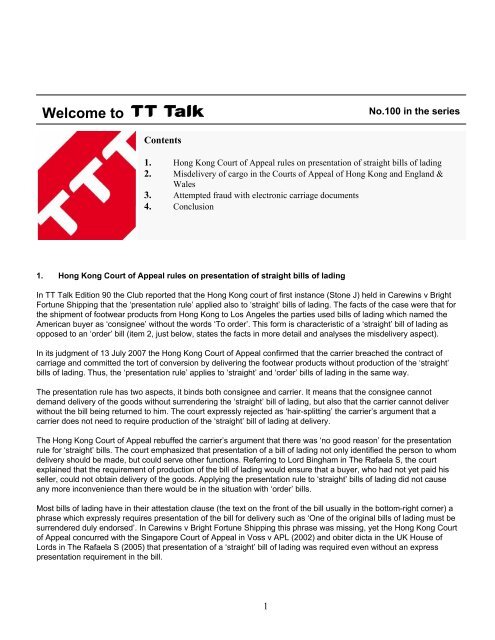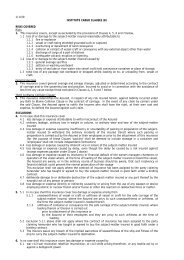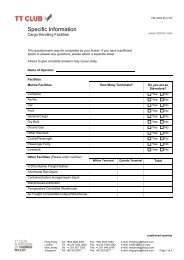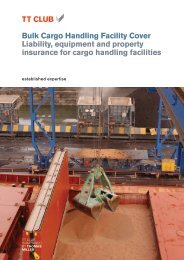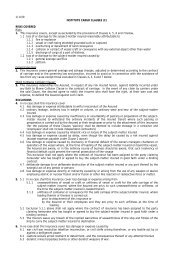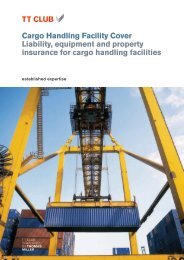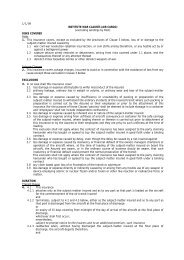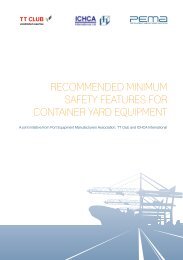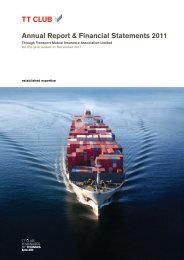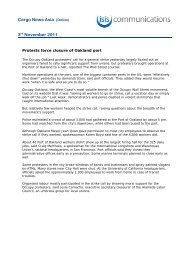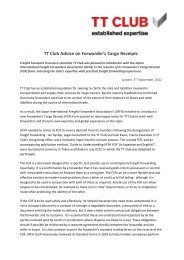TT Talk 100 - TT Club
TT Talk 100 - TT Club
TT Talk 100 - TT Club
You also want an ePaper? Increase the reach of your titles
YUMPU automatically turns print PDFs into web optimized ePapers that Google loves.
Welcome to<br />
No.<strong>100</strong> in the series<br />
Contents<br />
1. Hong Kong Court of Appeal rules on presentation of straight bills of lading<br />
2. Misdelivery of cargo in the Courts of Appeal of Hong Kong and England &<br />
Wales<br />
3. Attempted fraud with electronic carriage documents<br />
4. Conclusion<br />
1. Hong Kong Court of Appeal rules on presentation of straight bills of lading<br />
In <strong>TT</strong> <strong>Talk</strong> Edition 90 the <strong>Club</strong> reported that the Hong Kong court of first instance (Stone J) held in Carewins v Bright<br />
Fortune Shipping that the ‘presentation rule’ applied also to ‘straight’ bills of lading. The facts of the case were that for<br />
the shipment of footwear products from Hong Kong to Los Angeles the parties used bills of lading which named the<br />
American buyer as ‘consignee’ without the words ‘To order’. This form is characteristic of a ‘straight’ bill of lading as<br />
opposed to an ‘order’ bill (item 2, just below, states the facts in more detail and analyses the misdelivery aspect).<br />
In its judgment of 13 July 2007 the Hong Kong Court of Appeal confirmed that the carrier breached the contract of<br />
carriage and committed the tort of conversion by delivering the footwear products without production of the ‘straight’<br />
bills of lading. Thus, the ‘presentation rule’ applies to ‘straight’ and ‘order’ bills of lading in the same way.<br />
The presentation rule has two aspects, it binds both consignee and carrier. It means that the consignee cannot<br />
demand delivery of the goods without surrendering the ‘straight’ bill of lading, but also that the carrier cannot deliver<br />
without the bill being returned to him. The court expressly rejected as ‘hair-splitting’ the carrier’s argument that a<br />
carrier does not need to require production of the ‘straight’ bill of lading at delivery.<br />
The Hong Kong Court of Appeal rebuffed the carrier’s argument that there was ‘no good reason’ for the presentation<br />
rule for ‘straight’ bills. The court emphasized that presentation of a bill of lading not only identified the person to whom<br />
delivery should be made, but could serve other functions. Referring to Lord Bingham in The Rafaela S, the court<br />
explained that the requirement of production of the bill of lading would ensure that a buyer, who had not yet paid his<br />
seller, could not obtain delivery of the goods. Applying the presentation rule to ‘straight’ bills of lading did not cause<br />
any more inconvenience than there would be in the situation with ‘order’ bills.<br />
Most bills of lading have in their attestation clause (the text on the front of the bill usually in the bottom-right corner) a<br />
phrase which expressly requires presentation of the bill for delivery such as ‘One of the original bills of lading must be<br />
surrendered duly endorsed’. In Carewins v Bright Fortune Shipping this phrase was missing, yet the Hong Kong Court<br />
of Appeal concurred with the Singapore Court of Appeal in Voss v APL (2002) and obiter dicta in the UK House of<br />
Lords in The Rafaela S (2005) that presentation of a ‘straight’ bill of lading was required even without an express<br />
presentation requirement in the bill.<br />
1
The <strong>Club</strong> welcomes the judgment by the Hong Kong Court of Appeal on the presentation of ‘straight’ bills of lading.<br />
The judgment not only clarifies Hong Kong law (it expressly overrules as ‘wrong’ the first instance decision in The ‘Brij’<br />
(2003) which had held that a ‘straight’ bill of lading did not need to be presented), but also creates firm consistency<br />
with recent developments under Singapore and English law.<br />
The last point to note is that the carrier in Carewins v Bright Fortune Shipping argued that the parties had actually<br />
agreed that he was entitled to deliver the goods to the consignee without requesting presentation of the ‘straight’ bills<br />
of lading, yet (before the court of first instance) the carrier was unable to provide proof of such an agreement. The<br />
<strong>Club</strong> strongly recommends to Members who assume liability as carrier not to agree to delivery of the goods<br />
without presentation of the straight bill of lading as such an agreement would conflict with the presentation<br />
rule. If the parties prefer delivery without production of the carriage document, they should not use a ‘straight’ bill of<br />
lading, but instead a simple sea waybill.<br />
The full texts of this judgement can be found under the following web link (which is given also at the end of item 2,<br />
below):<br />
http://legalref.judiciary.gov.hk/lrs/common/search/search_result_detail_frame.jsp?DIS=57758&QS=%28carriage%29&<br />
TP=JU<br />
2. Misdelivery of cargo in the Courts of Appeal of Hong Kong and England & Wales<br />
a) Carewins v Bright Fortune Shipping (Hong Kong Court of Appeal, 13 July 2007)<br />
Carewins sold footwear products to Artist Fashion in Los Angeles. Bright Fortune Shipping assumed liability as carrier<br />
subcontracting the ocean carriage to a shipping line. Upon arrival at the port of Los Angeles, the arrangements for the<br />
handling of the containers were undertaken by a company called TUG pursuant to an agency agreement with Bright<br />
Fortune Shipping. Carriage from the port of Los Angeles to Artist Fashion’s warehouse was one hour by road. After<br />
the arrival of the footwear products at Artist Fashion’s warehouse, Burberry sued Artist Fashion for trade mark<br />
infringement. The footwear products were seized and never returned to Artist Fashion, who did not pay Carewins for<br />
the goods. As the contracting carrier Bright Fortune Shipping delivered the goods without requesting the bills of<br />
lading, Carewins sued Bright Fortune Shipping for the invoice price claiming misdelivery.<br />
The carrier’s bill of lading in clause 2(b) expressly excluded liability for misdelivery: ‘(…) the carrier shall be under no<br />
liability in any capacity whatsoever for loss or misdelivery of or damage to the goods however caused whether or not<br />
through the negligence of the carrier, his servants, agents or sub contractors (…)’.<br />
As reported in <strong>TT</strong> <strong>Talk</strong> Edition 90, the court of first instance (Stone J) considered whether the carrier’s liability for<br />
misdelivery was governed by the (mandatory) Hague-Visby Rules or by the parties’ contract as evidenced in the bill of<br />
lading. The judge found that ‘discharge’, at which point the application of the Hague-Visby Rules ended, occurred<br />
before clearance of the footwear products by US customs, and that the misdelivery only took place later when the<br />
carrier delivered the goods to TUG, i.e. before the land carriage. The judge then held that the exclusion of liability for<br />
misdelivery was ‘couched in clear terms, with express reference to misdelivery howsoever caused’ hence the<br />
exclusion clause in the bill of lading protected the carrier. Accordingly, he dismissed Carewins’ claim.<br />
However, the Hong Kong Court of Appeal allowed Carewins’ appeal for two reasons. First, the court dissected clause<br />
2(b) of the bill of lading and held that the scope of the wide term ‘however caused’ was being reduced by the addition<br />
‘whether or not through the negligence’. The Court of Appeal stated that misdelivery could be committed in ways that<br />
do not involve any consideration of negligence or non-negligence and that Carewins v Bright Fortune Shipping was<br />
such a case because the carrier misdelivered the goods intentionally despite non-production of the ‘straight’ bill of<br />
lading. Accordingly, the court held that clause 2(b) did not cover misdelivery in the way it actually occurred and added<br />
that had the carrier’s conditions simply stated ‘misdelivery (…) however caused’, i.e. without referring to negligence,<br />
they might have been sufficiently clear to exclude the carrier’s liability for misdelivery. The Court of Appeal interpreted<br />
clause 2(b) fundamentally different from Stone J at first instance who had said it was difficult to disagree with the<br />
2
carrier that, if this particular clause were not to be upheld, it would not be easy to conceive of any clause that could<br />
exclude liability for delivery.<br />
Secondly, the Hong Kong Court of Appeal scrutinized how clauses 2(a) and 2(c) of the bill of lading conditions related<br />
to each other and to the information on the front of the bill. Clause 2(a) stated that the carrier was liable subject to US<br />
COGSA between ‘loading’ and ‘discharge’, but clause 2(c) defined the period of liability as ‘between the time the<br />
Goods are received (…) and the time of delivery’. Emphasizing the need to read the carriage contract as a whole, the<br />
court went on to examine the front of the bill, where ‘Port of Discharge’, ‘Place of Delivery’ and ‘Final Destination’ were<br />
all identically described as ‘Los Angeles, CA’. The court deemed this reference ambiguous because the phrase might<br />
be referring either merely to the port area of the city of Los Angeles or to the entirety of Los Angeles as a port city.<br />
From the manner in which these boxes on the front were completed in this case, the court concluded that the periods<br />
of loading-discharge and receiving-delivery in clauses 2(a) and 2(c) on the back were in fact the same and that it was<br />
plausible that the parties regarded ‘discharge’ and ‘delivery’ as equivalent operations. Consequently, the court held<br />
that ‘delivery’ occurred within the period of loading-discharge of clause 2(a) which meant that US COGSA applied to<br />
the misdelivery. As the COGSA limit of US$500 per package fully covered the invoice value of the goods, the Court of<br />
Appeal awarded US$873,028. Again, compare the reasoning by the Court of Appeal with Stone J at first instance who<br />
felt that there was in principle no justification for extending the concept of ‘discharge’ beyond final unloading as this<br />
would be tantamount to regarding the carrier both as carrier and warehouseman.<br />
The Court of Appeal reversed Stone J’s first instance judgment based on its interpretation of the carrier’s bill of lading,<br />
which meant that the court did not need to deal in its judgment in detail with the geographical scope of the Hague-<br />
Visby Rules and the validity of limitation clauses which defeat the main purpose of a carriage contract.<br />
b) MSC v Trafigura Beheer (England and Wales Court of Appeal, 27 July 2007)<br />
Aikens J at first instance stated the facts in his judgment of 26 April 2007. A total of 18 containers which held 360<br />
tones of copper cathodes (worth some US$2 million) were shipped from Durban to Shanghai. The true consignee<br />
tried to obtain delivery orders for the cargo, but was told they had already been issued to someone else.<br />
Investigations revealed a fraud (further on this, please see item 5, below). Luckily the carrier was able to instruct the<br />
container terminal not to release the containers from the terminal without further instructions. Due to legal proceedings<br />
in China, the containers remained in the Shanghai container terminal. The consignee sued the carrier in England for<br />
delivery of the cargo or for damages for the conversion of the cargo.<br />
The England and Wales Court of Appeal first held that the Hague Rules applied to the sea carriage as a matter of<br />
contract. After that, the court considered whether the Hague Rules also applied after discharge of the cargo from the<br />
vessel, i.e. to the period when the containers remained in the Shanghai container terminal. Based on an examination<br />
of authorities including Pyrene v Scindia (1954) and the Court of Appeal judgment in The Captain Gregos (1990), the<br />
court held that for periods outside the actual carriage the parties are free to agree on terms other than the Hague (or<br />
Hague-Visby) Rules.<br />
Then the Court of Appeal scrutinized the bill of lading conditions in spite of their 'elaborateness and illegibility' and<br />
held these conditions indicated that the parties did not intend the Hague Rules to apply after discharge of the goods<br />
from the vessel. One reason for this finding was that clause 7 of the conditions referred to loss 'after the end of the<br />
Hague Rules period'.<br />
Having found the Hague Rules inapplicable to the post-discharge period, the Court of Appeal considered whether the<br />
carrier was entitled to rely on any exclusions or limitations of liability in his bill of lading conditions. The carrier sought<br />
to rely on clause 22, described by the court as 'elaborate and scarcely legible', where the 5th and the 7th sentence (of<br />
15 sentences in total) limited his liability to Hague Rules level. However, the Court of Appeal held that any exemption<br />
or limitation of liability for the essential obligation to delivery against an original bill of lading had to be clearly<br />
expressed and that the 'melee' of provisions contained in clause 22 did not achieve this purpose – this long clause did<br />
not even expressly refer to 'misdelivery'. Thus, the Court of Appeal held the carrier liable for the invoice value of the<br />
goods, but not for cargo interests' hedging losses because these were not foreseeable to the carrier.<br />
3
c) Comparison<br />
In both cases the carriers were held liable for the full invoice value of the goods, and lost owing to the manner their<br />
bills of lading conditions were worded. A comparison of the chances of the carriers in the two court cases might<br />
conclude that the task of the carrier in Carewins v Bright Fortune Shipping was, for different reasons, both easier and<br />
more difficult: easier because the pertinent bill of lading provision in his bill of lading was reasonably concise and<br />
expressly referred to misdelivery, and more difficult because he was looking to exclude, rather than merely limit, his<br />
liability.<br />
No doubt these two cases will cause some carriers to review how their bill of lading provisions can better protect them<br />
against claims for misdelivery, but these two Court of Appeal cases might actually illustrate that some courts are<br />
reluctant to allow carriers to escape liability for their fundamental obligation to deliver the cargo in the manner they<br />
agreed. <strong>TT</strong> <strong>Talk</strong> Edition 93 already indicated that a carrier cannot be sure that an exemption clause in his bill of lading<br />
will protect him from liability for misdelivery; for this reason, the <strong>Club</strong> recommends that Transport Operator<br />
Members protect themselves in any case by implementing proper cargo delivery procedures.<br />
The full texts of these two judgements can be found under the following web links:<br />
- Carewins v Bright Fortune Shipping, Hong Kong Court of Appeal, 13 July 2007<br />
http://legalref.judiciary.gov.hk/lrs/common/search/search_result_detail_frame.jsp?DIS=57758&QS=%28carriage%29&<br />
TP=JU<br />
- MSC v Trafigura Beheer, England and Wales Court of Appeal, 27 July 2007<br />
http://www.bailii.org/ew/cases/EWCA/Civ/2007/794.html<br />
3. Attempted fraud with electronic carriage documents<br />
A remarkable aspect in MSC v Trafigura Beheer (discussed in item 2, just above) was, in the words of Aikens J, the<br />
‘international conspiracy’ to steal the 18 containers.<br />
As Aikens J stated in his judgment at first instance of 26 April 2007, the shipper’s agent provided the information for<br />
the ‘shipper’, ‘consignee’ and ‘notify party’ boxes for the production of the genuine bill of lading. The bill was<br />
generated in a ‘template’ bill of lading displayed on a computer screen. An authorised employee of the carrier signed<br />
the genuine bill of lading as agent for the ship’s master, next the bill (in a set of three originals) was released to the<br />
shipper. When this genuine bill of lading was produced, the carrier also entered details of the cargo, shipper,<br />
consignee and notify party on a computerised version of the vessel’s cargo manifest.<br />
At that point the fraudsters started interfering. They used employees of the carrier’s agents in Durban to produce a<br />
fraudulent second set of bills of lading, where a Shanghai company was falsely named as the consignee. The vessel’s<br />
cargo manifest was also altered in order to tally with the information in this fraudulent bill of lading. The false bills of<br />
lading were then sent to the fraudsters in Shanghai, who succeeded in obtaining a deliver order for the containers<br />
from the carrier’s local agent. Based on this delivery order the fraudsters paid customs duty and VAT on the cargo<br />
and thereby obtained permission by the customs authorities to discharge the 18 containers from the container<br />
terminal. However, before the fraudsters had an occasion to take the containers away, the true consignees applied for<br />
delivery orders, which lead to investigations that uncovered the attempted fraud. Had the true consignee requested<br />
delivery orders a day or two later, the fraudsters’ sting to obtain the cargo worth some US$2 million might have<br />
worked.<br />
4
Aikens J said that the fraudulent set of bills of lading and the change to the ship’s cargo manifest did not raise any<br />
suspicions because the bills of lading and the manifest were produced electronically. This comment raises the<br />
question whether electronically produced carriage documentation is more susceptible to fraud than traditional paper<br />
documents. The fraudsters’ sting was a daring attempt that required careful planning and involved operations both in<br />
South Africa and China. The <strong>Club</strong> asks Terminal Operator and Transport Operator Members to be aware that<br />
criminals might attempt to commit sophisticated frauds with falsified documents and to take all practical<br />
steps possible to avert such frauds.<br />
4. Conclusion<br />
We hope that you will have found the above items interesting. If you would like to have further information about any<br />
of them, or have any comments you would like to make, please email the editor at tt.talk@ttclub.com. We look<br />
forward to hearing from you.<br />
Peter Stockli<br />
Editor<br />
For the <strong>TT</strong> <strong>Club</strong><br />
<strong>TT</strong> <strong>Talk</strong> is a free electronic newsletter published as occasion demands, by the <strong>TT</strong> <strong>Club</strong>, International House, 26<br />
Creechurch Lane, London EC3A 5BA, United Kingdom.<br />
You can also read this newsletter and past issues on our website: http://www.ttclub.com<br />
If you do not wish to receive future editions, please reply to this message and include the word "REMOVE" in the<br />
subject line. If you have received this edition via someone else and you would like your own personal copy in future,<br />
please send your name, company name and e-mail address to:<br />
tt.talk@ttclub.com<br />
5


